Author Archive
July 2, 2017
Basic Gold Prospecting Equipment
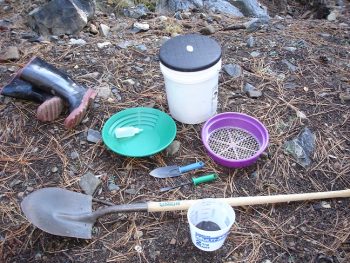 For recreational gold prospectors the fun and excitement in prospecting is not merely the hunt to find gold, but also the outdoor adventure and interaction with nature. Gold prospecting actually teaches some valuable life lessons: like the hard work miners put in to find gold, their hopes of discovering fortunes, and how they survived for many years during the gold rush. And most of those miners did not use modern gold prospecting equipment such as metal detectors, motorized sluice boxes, or modern suction dredges.
For recreational gold prospectors the fun and excitement in prospecting is not merely the hunt to find gold, but also the outdoor adventure and interaction with nature. Gold prospecting actually teaches some valuable life lessons: like the hard work miners put in to find gold, their hopes of discovering fortunes, and how they survived for many years during the gold rush. And most of those miners did not use modern gold prospecting equipment such as metal detectors, motorized sluice boxes, or modern suction dredges.
If you are interested in prospecting today you don’t have to purchase state-of-the-art dredging or sluicing equipment to find gold. A few pieces of basic equipment should cover your needs in most cases, and you can trade your gold for better equipment at the gold supply store. Here are some of the most basic and relatively inexpensive pieces of prospecting equipment to get you started.
The Gold Pan: Although the gold pan is considered the most basic piece of equipment, it is also one of the most effective. Beginners and seasoned prospectors alike will find various situations where the gold pan is more useful than any other tool. Various designs are available, and a common feature across many models are the riffles used to trap gold during agitation, and to easily remove the gold when the agitation process is done. Some gold pans are made of heavy-duty metals, while the most popular and desirable are high-impact plastic.
The Sluice Box: Using only a gold pan to harvest gold takes a very long time. To speed up the process without going into debt, a small non-motorized sluice box is used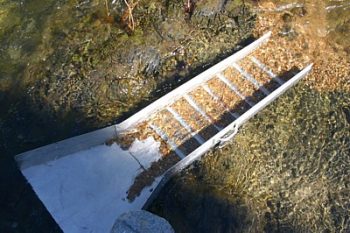 . Instead of working one pan at a time the prospector slowly shovels the dirt into the mouth of the sluice box letting the natural flow of water wash the lighter materials away while also catching heavier materials like gold in the riffles. After a few hours of this process the miner takes the concentrates (sediment) from the bottom of the sluice box and pans that down to just the gold, hopefully.
. Instead of working one pan at a time the prospector slowly shovels the dirt into the mouth of the sluice box letting the natural flow of water wash the lighter materials away while also catching heavier materials like gold in the riffles. After a few hours of this process the miner takes the concentrates (sediment) from the bottom of the sluice box and pans that down to just the gold, hopefully.
The Shovel: While a shovel seems like an obvious piece of gold prospecting equipment, they actually come in various sizes for different situations. Some of the better prospecting shovels are thinner and longer with serrated edges to cut through hard packed soils and river stone. A small spade with serrated edges is also a must have item as you will find your full size shovel just doesn’t work in smaller crevices where gold might accumulate.
The Pick: The pick is another obvious tool that saves lots of time. Gold is often found mixed in with old river stone and soil. When dry that soil can be like concrete, and that’s when a good pick comes in handy. And like the shovel, picks come in different sizes and you will probably use both during the course of a days worth of digging.
The Classifier: The classifier is a round screen that fits perfectly on top of the gold pan. The objective is to shovel your material into the classifier as it sits on top of the pan then place both in water for the initial agitation. Doing so separates the heavier rock from the soil which falls through the screen into the pan–where flakes of gold may be found. But be careful while throwing those rocks back into the stream–one of them could be a gold nugget. The classifier is another piece of gold prospecting equipment that is cheap and really speeds up the processing, and in gold prospecting, it’s all about processing dirt–lots and lots of dirt.
The Gold Map: A good gold map can save the prospector $100’s in gas alone. Not to mention time and effort spent processing dirt where little to no gold has been found. We sell a digital gold claim map viewed as an overlay in Google Earth which can be taken to the field with you on your smartphone, tablet or laptop. It’s not enough to have a paper gold map that shows only areas where gold was found–you need to know in advance if that area is all claimed up. It’s a waste of time and money to get to an area only to learn you can’t prospect there. And with a gold claim map like ours we can put you on an abandoned claim that might sit right between two money maker claims, and you are legal.
For the recreational gold prospector it is important to understand that you don’t have to spend ridiculous amounts of money just to get involved in the activity. While some basic equipment can run into $100’s of dollars, most gold panning supply stores have used equipment for a fraction of the cost of new. And for whatever it’s worth, after a day of prospecting your shiny new sluice box or special shovel will look just like the used one you saw at the store. Metal is metal, and gold prospecting equipment will usually outlive the owner. Something else to consider, a lot of open placer sites don’t allow anything motorized on the property, or they might require a special costly permit.
Gold Prospecting Knowledge: Without any doubt the most valuable tool the prospector has is his/her knowledge of where gold might be found, and how to best get that gold out of the ground. And considering finding gold is all about processing dirt, a little knowledge of gold can put you on the right dirt to process. Things to consider are:
- where gold has been found in the past
- public lands open for recreational mining
- Where gold collects along streams and rivers
- prospecting strategies like what tools will I need
A good prospectors knows the stream they are at once flowed much higher up than today. Look up the hillside to see if there is a big rock that might have once captured gold when the stream was higher. Gold will collect on the down-stream side of big rocks so the greatest amount of gold might be a few yards up the hill on the down-stream side of that rock. Fill a bucket with some of that dirt and drag it down to the stream and pan it.
The BLM and U.S. Geological Survey provides basic information about gold prospecting locations and mining history. There are also a lot of “how to” videos on gold panning basics on YouTube. You don’t need to buy a video to learn basic prospecting and panning techniques. The old timers didn’t get it all so if you’re down stream from an important old mine, you’ll probably find placer gold in the stream. And keep in mind that tons of new gold gets washed into streams each year as rain and swollen rivers replace previously harvested areas thought to be “picked clean.”
June 18, 2017
Best Placer Gold Prospecting Locations
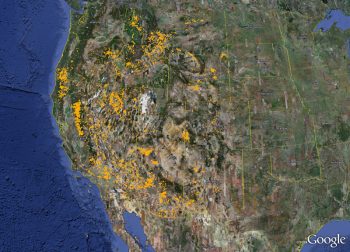 Sparkling gold in the bottom of a pan is one of the most rewarding experiences that any gold prospector can ask for–and the bigger the flakes and clinkers, the happier the prospector. While some say that hunting for gold is the most fun, the hunt will never be as much fun as actually finding gold. Hopefully the below listed gold prospecting locations will make the hunt worth it. But first, a few pro tips about gold prospecting to save time and money–because spending $1000 to find $100 worth of gold is not a strategy.
Sparkling gold in the bottom of a pan is one of the most rewarding experiences that any gold prospector can ask for–and the bigger the flakes and clinkers, the happier the prospector. While some say that hunting for gold is the most fun, the hunt will never be as much fun as actually finding gold. Hopefully the below listed gold prospecting locations will make the hunt worth it. But first, a few pro tips about gold prospecting to save time and money–because spending $1000 to find $100 worth of gold is not a strategy.
Gold Prospecting Equipment
Finding gold with just a gold pan makes it tougher on the prospector, but it is possible. So if a pan and shovel are your only tools, common sense says you’ll need to prospect the most promising areas to make your effort work. That said, there is an old adage among prospectors: The best place to find gold is where gold is already being found. A gold claim map is a good way to see where gold is being found, and this small investment can be covered by a single flake or clinker–not to mention make your time and effort worthwhile. And a word to the wise; paper gold maps only show where gold deposits are located–they do not show any of the claims that might cover those deposits. Only a good gold claim map will give you that information. So don’t waste gas money following a paper gold map only to discover you are not allowed to prospect there because the land is all claimed up.
Modern Recreational Gold Prospecting
While much of the easy gold has been found, there is said to be roughly 85% of the precious metal still in the ground. Every year new gold is washed down the hills and into the streams waiting to found. Many large lode miners left millions in gold-rich ore behind because it just wasn’t profitable at the level they mine. But these abandoned deposits can be very profitable for the small scale miner looking for a few ounces per week. Other viable gold claims were abandoned because the price dropped, or the country was at war leaving little time to focus on gold mining. Considering the price of gold today and the tools and technology the modern prospector has access to, gold prospecting can still be very rewarding.
Placer Gold Prospecting Locations
Most people are not comfortable going deep inside a lode mine to collect and process ore. While the rewards can be high, the risks are high as well. The chance of the mine collapsing can often-times be minimal. It’s the gases and mold that can create the greatest danger. That said, placer mining in rivers and streams can be the most rewarding with little to no risk involved. Some of the best locations of placer deposits are as follows:
- California: The Mother Lode region including the Cosumnes, Mokelumne, Feather, American, Yuba and Calaveras Rivers. The Trinity River in Northern California still produces gold as well.
- Alaska: The Yukon River along with its tributaries, Fairbanks District, Nome District, Copper River, and the Kuskokwim River.
- Montana: Alder Gulch in Madison County, Helena Mining District, Last Chance Gulch, Clark Fork of the Columbia River, and the Butte District. Especially the Butte District.
- Idaho: Boise Basin, Salmon River, the Clearwater River along with its tributaries, Snake River, Fairplay District in Park County, and Breckenridge District in Summit County.
- Oregon: All streams that drain from the Wallowa and Blue Mountains, the vicinity of Sumpter (upper Powder River), Burnt River along with its tributaries, and John Day River valley in the southwestern area of the state. The tributaries of the Rogue River also produce gold as well as the streams in the Klamath Mountains. The Greenback District in Josephine County and Applegate District in Jackson County also produce gold.
- Arizona gold prospecting locations: There are plenty, but the best might be around Meadview in the gold basin area. This area is said to be the last place in America where you can still find gold nuggets laying on the ground.
Pro tip for placer miners: The river or creek you are panning was higher 1000 years ago. Look at the surrounding banks and see if you can spot ancient collection points. Dig some of that dirt and drag it down to the water for panning. You might discover that 30 yards up the hill from the creek is a respectable pay streak. Believe it or not, most people don’t know this. If you have a metal detector, sweeping higher up the hill can make this effort easier still. If you find a nugget you probably found some flakes as well.
At the end of the day, there are thousands of placer gold prospecting locations on public lands holding billions of dollars in gold just waiting to be harvested. A good gold claim map, a shovel, a gold pan, and a smart plan are all you need to get started. Take the gold you found and trade it for a sluice box at the mining supply store. Then take the gold you find with the sluice box and trade it for a high-banker. It’s not exaggerating at all to say you could have the very best prospecting equipment in a single season after starting with only the most basic tools.
May 23, 2017
Wyoming Gold Mines
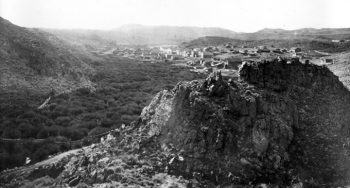 Gold does not have a strong association with Wyoming. As a matter of fact, most people will think about cattle or oil when they are talking about the state. Compared to its neighboring states, Wyoming gets very little attention as far as gold mining is concerned. Population density is also lower than any other state, so it makes sense that gold exploration is not too popular here. Despite all of that, a good amount of gold has been recovered although not as much as from other states. Wyoming gold mines have never had their best season yet due to the nature of the state’s long and unfriendly winters.
Gold does not have a strong association with Wyoming. As a matter of fact, most people will think about cattle or oil when they are talking about the state. Compared to its neighboring states, Wyoming gets very little attention as far as gold mining is concerned. Population density is also lower than any other state, so it makes sense that gold exploration is not too popular here. Despite all of that, a good amount of gold has been recovered although not as much as from other states. Wyoming gold mines have never had their best season yet due to the nature of the state’s long and unfriendly winters.
In the present-day Fremont County, more precisely at the South Pass-Atlantic City, gold was discovered in 1842. For about 15 years, placers in the area were explored albeit intermittently. Many towns surrounding the areas transformed to cater to the miners. By 1860’s, the state saw an increase in prospecting efforts. Many Wyoming gold mines were soon established including:
- South Pass-Atlantic City District: located in the southern edge of Wind River Range, the area has produced placer gold. Official production record showed poor recovery, but some people believe that the actual production was more than the amount reported. By 1875, this area was pretty much deserted but some miners still worked here intermittently. Total gold production was around 300,000 troy ounces (9.3 tons). After about 300 years of poor gold production, the area became an iron mine.
- Granite Mountain Range: many Wyoming gold mines were established in this area such as Tin Cup, Seminoe, and Rattlesnake Hills Districts. Again, those mines had poor gold recovery records; low grade gold ores were the main commodities. There have been some investigations suggesting that gold exists, but the amount is only financially plausible for recreational prospectors.
- Absaroka Mountains: gold has been recovered from several areas for examples Stinking Water, New World, and Sunlight Districts. Most recoveries were done by traditional methods such as dredging, sluicing, and panning. These areas do not attract commercial gold mining companies, but recreational prospectors have a good chance of finding gold here.
Wyoming is a relatively remote state in the country, so perhaps you need extra preparations and gear to do your gold prospecting activities. Be sure to buy a good Wyoming gold map to avoid claim jumping. A wide area of public lands are open for mineral exploration, which means you don’t need special permits to start your venture. The lack of commercial gold mining activity can be a good thing, but there is also the possibility that you don’t have any clue where to start. Best places are those areas with historical discoveries before you explore further.
May 21, 2017
Historic Utah Gold Mines
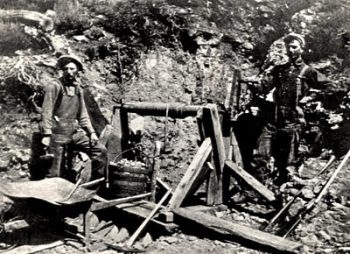 There is something unique about Utah. It is one of the leading states in terms of gold-production, but people do not seem to be very interested in the state for gold prospecting. The obvious reason is that much of the gold found in Utah was a byproduct of mining activities for other minerals including silver, copper, zinc, and lead. Today, the most lucrative gold producer is Bingham Canyon, which is a copper mine located just southwest of Salt Lake City. So far it has produced more than 23 million ounces (about 715 tons) of gold, making it one of the largest gold producers in the United States. For a mine designed to search for silver, this record is surprising.
There is something unique about Utah. It is one of the leading states in terms of gold-production, but people do not seem to be very interested in the state for gold prospecting. The obvious reason is that much of the gold found in Utah was a byproduct of mining activities for other minerals including silver, copper, zinc, and lead. Today, the most lucrative gold producer is Bingham Canyon, which is a copper mine located just southwest of Salt Lake City. So far it has produced more than 23 million ounces (about 715 tons) of gold, making it one of the largest gold producers in the United States. For a mine designed to search for silver, this record is surprising.
There are not a lot of Utah gold mines. The last major one was the Barneys Canyon which stopped mining in 2001. It is officially inactive, but the area is still able to recover considerable amounts of gold from the heap leaching pads. In 2006, total gold production from Utah reached 460,000 troy ounces (about 14 tons).
Most of Utah gold mines only yielded in minimal recoveries. The problem was that much of the gold was in extremely fine size and small quantities. As a result, early miners were not very encouraged to continue their exploration. The attention shifted towards other minerals, but then again there was another problem; the associated cost with recovering copper, silver, zinc, lead, and other minerals was too much for average prospectors. For modern day recreational prospectors, however, this should not be a problem. Rivers and creeks still provide a good enough challenge for them to enjoy the experience. Careful gold-panning is a must, or the gold will just be lost in the recovery process.
Some potential Utah gold mines include:
- Nearly all areas located southwest of Salt Lake City; this is basically around Bingham Canyon. Start with the creeks in the Oquirrh Mountains.
- Colorado River has produced some gold as well. Much of it is flower gold, so make sure you pay great attention in the recovery process.
- Green River located in the northeast corner of Utah has also produced gold. You may have better luck at the Flaming Gorge Reservoir.
- San Juan River in the southwest as well as several creeks in the Henry Mountains.
The best thing is that you don’t really need any permit to do recreational gold prospecting in the state, as long as you use non-motorized methods. Wide areas of public land is available for anybody to try their luck in finding the yellow metal.
May 13, 2017
Historic New Mexico Gold Mines
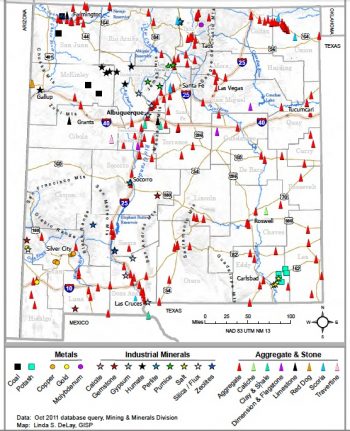 Over the past several hundred years, New Mexico has produced good amounts of gold. Total production is still lower than Arizona, but it does not necessarily mean that New Mexico is not a promising state. The first recorded gold discovery in the state happened in 1828 in Old Placers. The discovery was followed by establishments of many other New Mexico gold mines. Prior to 1904, total gold production from New Mexico was worth $6,750,000. Much of the gold is a byproduct of mining activities for other minerals. About a decade ago, all New Mexico gold mines ceased to exist. The state still produced gold in 2007, but all of them were byproducts of copper mining.
Over the past several hundred years, New Mexico has produced good amounts of gold. Total production is still lower than Arizona, but it does not necessarily mean that New Mexico is not a promising state. The first recorded gold discovery in the state happened in 1828 in Old Placers. The discovery was followed by establishments of many other New Mexico gold mines. Prior to 1904, total gold production from New Mexico was worth $6,750,000. Much of the gold is a byproduct of mining activities for other minerals. About a decade ago, all New Mexico gold mines ceased to exist. The state still produced gold in 2007, but all of them were byproducts of copper mining.
One of the biggest challenges for early miners was the lack of water. Extreme dry climate also limited production, but it also means that modern day prospectors still have a good chance of finding their fortunes. In the summer, the temperature can be challenging especially considering that you probably have to prospect in the desert. In most mining situations in New Mexico, metal detectors and dry-washing equipment are preferable. Smaller deposits are spread throughout the state, so it is important that you cover a lot of grounds.
Some of the most popular New Mexico gold mines are as follows:
- Hillsboro District: in both cemented and un-cemented gravels, gold can be found in this area. Located in the southwest part of the state, the district has been known to produce gold from dry-land dredges and dry-washing. There are gold-rich gulches in Hillsboro.
- Elizabethtown Baldy District: along the west side of Mount Baldy, this district is the most productive of them all. So far it has produced more than 100,000 ounces of gold including large gold nuggets. Modern day prospectors using metal detectors have the biggest chances of finding more nuggets.
- Old Placers: Cunningham and Dolores are preferable mining areas in Old Placers, especially for small scale prospectors. Located in the southwest of Santa Fe, there is also a place called New Placers; this is the area where high purity gold has been found.
- Pinos Altos: located just several miles north of Silver City, the district is basically a dry placer gold deposit. It has three gulches rich in gold including Whiskey, Santo Domingo, and Rich.
Please understand that many areas in New Mexico are private lands; some of them are for the military, and others are Indian Reservations. It is best to invest in a gold claim map to see where others are finding gold. Even when some lands do not fall into any of those categories, chances are you still require special permits to do your gold prospecting. A lot of existing popular New Mexico gold mines are already claimed. Make sure you check with local authorities before prospecting to avoid legal issues.
May 9, 2017
Historic Nevada Gold Mines Today
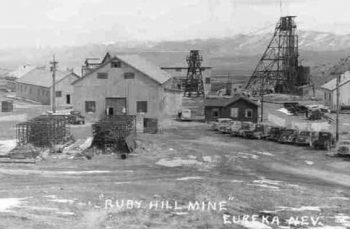 Every county in Nevada has gold, even when some of them are so fine that it is not financially plausible for an average prospector to start looking in the first place. Many Nevada gold mines had records of historical finding of much friendlier size in the past, so it is best to focus on those places for the most part. It is well worth the cost to buy a Nevada gold map to guide you to the best spots. Various techniques potentially yield good results too for examples using metal detector, panning, and dry washing. Metal detecting and dry washing are always preferable in Nevada gold mines because the state naturally is arid, hence limited water supply. Suction dredges and sluice boxes are of little use as well.
Every county in Nevada has gold, even when some of them are so fine that it is not financially plausible for an average prospector to start looking in the first place. Many Nevada gold mines had records of historical finding of much friendlier size in the past, so it is best to focus on those places for the most part. It is well worth the cost to buy a Nevada gold map to guide you to the best spots. Various techniques potentially yield good results too for examples using metal detector, panning, and dry washing. Metal detecting and dry washing are always preferable in Nevada gold mines because the state naturally is arid, hence limited water supply. Suction dredges and sluice boxes are of little use as well.
In Humboldt County located in the northern part of Nevada, gold is spread all across the area. Large nuggets have been found in the county, making it a good place for modern day prospectors. Other places to explore include the Dutch Flats, Winnemucca District, Rebel Creek, and Varyville District; they have produced several thousands of ounces. In the old days where miners were only using traditional equipment, much of the gold is probably left behind, so metal detectors can be effective in dry-wash areas. In addition to the aforementioned locations, Nevada gold mines can be found in Gold Run, Paradise Valley, The Awakening, and Warm Spring Districts.
Nevada is the most lucrative gold-producing state in the country. In 2015, it produced nearly 5.4 million ounces (166 tons) of gold. This amount represented 78% of US gold and 5.4% of world’s production. Large open pit mining locations have been the largest producers so far. Today there are still active mining companies in the state including Kinross Gold, Barrick Gold, and Newmont Mining. Some of the active mines are Cortez, Betz-Post, Twin Creeks, Getchell, and Jerritt Canyon.
Modern day prospectors should be aware of the harsh climate of Nevada before they even try to explore the territory. A combination of sparse water and hot summer can lead to great discomfort for the unprepared. Population density is also quite low for a popular gold producer. When you are searching for gold, chances are you have to go through rough terrain filled with wildlife, too.
Nevada offers you not only gold, but also silver in its ground. Many smaller counties near Carson City and Reno are popular destinations for recreational gold mining activities. Other locations include:
- Lyon County: many people believe that the first gold discovery in Nevada occurred in Lyon County. It still is productive to this day.
- Washoe County: gold has been found throughout the county, but mostly from smaller prospects. Total production is relatively low compared to other counties.
- Storey County: gold and silver are waiting to be found.
- Douglas County: there is gold, but only in small quantity, so it is not ideal for recreational prospectors.
May 4, 2017
Historic Montana Gold Mines Today
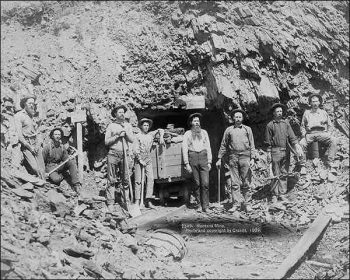 Montana and Idaho stand side by side. Most gold in Montana has been found in the western part of the state near the border of Idaho. This part is filled with difficult terrain of rugged mountains along the Continental Divide; almost all the remaining parts of the state are flat land areas. The geological conditions are probably not ideal, but no one ever said finding gold is easy.
Montana and Idaho stand side by side. Most gold in Montana has been found in the western part of the state near the border of Idaho. This part is filled with difficult terrain of rugged mountains along the Continental Divide; almost all the remaining parts of the state are flat land areas. The geological conditions are probably not ideal, but no one ever said finding gold is easy.
Montana had its first gold discovery in 1852, or about a decade earlier than in Idaho. However, the whole idea of the Montana gold rush started in 1862 in Grasshopper Creek. Among all Montana gold mines, the Bannack (present-day Dillon, Montana) was probably the first to establish its existence in the state; it was quickly built and soon inhabited by thousands of miners in search of the yellow precious metal. It did not take long until the next potential gold mine was found. In 1863, Alder Gulch made its way into the map thanks to a discovery of a considerable sized deposit. More Montana gold mines surfaced as a result of the rush including Helena and Butte in 1864 and Atlantic Cable Quartz Lode in 1867. Butte district was primarily mined for its silver, yet it has produced almost 3 million ounces of gold through the 1990s. For a byproduct, that was actually a lucrative record.
Today’s active Montana gold mines include the Golden Sunlight and Montana Tunnels. Some gold placers are also still in production such as the Confederate Gulch and Browns Gulch. Even several titanium mines produce gold as well for example East Boulder Project, Stillwater, and Lodestar.
Montana is not a small state by any means. Records of gold discoveries and production have been good, so modern day prospectors still have a good chance to find fortunes here. All sorts of mining methods can work too including panning, dredging, sluicing, and using a metal detector. As discussed earlier, most of the gold is in the western part of the state; there are few exceptions, but you will have better chances of finding the gold if you look around that area.
Despite the long-running exploration for more than 150 years, Montana remains a good state for gold prospecting. Your search should start at historical creeks and the remnants of old mines. Large gold nuggets have been found in the state, so a metal detector should not be left behind in your exploration. You can find an excellent Montana gold map on this website. The biggest problem is that many (if not most) of the productive areas are already claimed, but there are still wide enough public lands for everyone to search for gold in the state.
April 25, 2017
Historic South Dakota Gold Mines Today
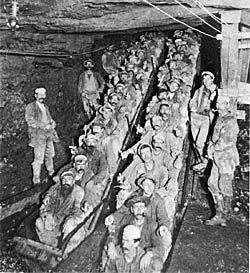 The first important gold discovery in South Dakota occurred in 1874 by a group of people led by General Custer. The area was later known as the Black Hills, and the news attracted quite a lot of people in search of fortunes despite the difficulties and challenges presented by the local Sioux Indians. Even after hundreds of years of initial discovery, Black Hills remain one of the most attractive South Dakota gold mines for modern day prospectors. It has been explored extensively ever since, but many believe that it still hides plenty of gold.
The first important gold discovery in South Dakota occurred in 1874 by a group of people led by General Custer. The area was later known as the Black Hills, and the news attracted quite a lot of people in search of fortunes despite the difficulties and challenges presented by the local Sioux Indians. Even after hundreds of years of initial discovery, Black Hills remain one of the most attractive South Dakota gold mines for modern day prospectors. It has been explored extensively ever since, but many believe that it still hides plenty of gold.
Compared to any other South Dakota gold mines, the Homestake Mine is undeniably the most lucrative. So far it has produced more than 40 million ounces of gold. It was first established in 1876 in Lead, and it had produced about 10% of the world’s gold supply for the next 125 years. A lot of prospectors actually tried to search for anything similar to Homestake Mine, but this was indeed one of a kind.
Homestake Mine had been active for centuries before it was closed in 2002. Throughout its active years, it has produced more than 40 million troy ounces (around 1.25 million kilograms) of gold. This particular mine is also popular in the scientific world for being the site where the solar neutrino problem was first discovered; today the phenomenon is known as The Homestake Experiment. In the 1960s, a deep underground laboratory was established in the area, and this was the first facility designed to observe the solar neutrinos.
In the neighboring towns of Lead, there are quite a lot of other South Dakota gold mines; for example Yellow Creek, Annie Creek, Squaw Creek, Deadwood Creek, Elk Creek, and Strawberry Creek. Gulches and lode gold mines were all explored. Both lode deposits and placer gold are potentially still there to be found. Today the only active gold mine in the state is Wharf Mine, also located in Lead. It is basically an open pit operation overseen by Coeur Mining. In 2016, the mine produced more than 100,000 ounces of gold.
Modern day prospectors should understand that many of the aforementioned creeks are not open mining areas. They are already claimed or located in private properties. Some good gold maps are advisable. Please make sure you carry the proper permits for gold prospecting or at least check with local authorities. Be prepared to explore new areas as you may not have any luck with the existing popular ones.
Historic Idaho Gold Mines Today
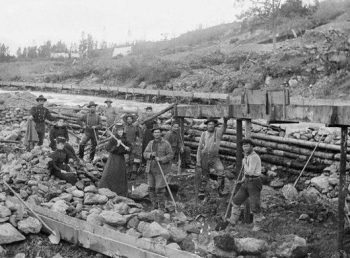 Among all states in the country, Idaho is one of the most productive in terms of gold mining. Another good thing is that about 75% of the land all across the state is public land and managed by the Bureau of Land Management and Forest Service, allowing everyone to prospect for gold without worrying about trespassing into privately-owned properties. It does not sound like much, but acquiring the permit to prospect gold without legal issues can be indeed quite a hassle.
Among all states in the country, Idaho is one of the most productive in terms of gold mining. Another good thing is that about 75% of the land all across the state is public land and managed by the Bureau of Land Management and Forest Service, allowing everyone to prospect for gold without worrying about trespassing into privately-owned properties. It does not sound like much, but acquiring the permit to prospect gold without legal issues can be indeed quite a hassle.
Dozens of Idaho gold mines have been found, but most of them are in difficult-to-access areas. This means an average prospector must also be prepared to do a little bit more leg-work to find good spots for the venture. Gold was first discovered in Idaho in 1860. It was in Pierce at the juncture where Orofino Creek meets the Canal Creek.
Following that discovery, more Idaho gold mines came to existence including:
- Boise Basin: the leading gold-producing district in the state. Gold was discovered in 1862, and so far it has produced more than 2.9 million troy ounces (over 90 tons) of gold. Most of them were from placers. Only within several years after the first discovery, Boise Basin had a larger population than Portland, Oregon. Large gold nuggets are rare, but few specimens have been found.
- French Creek-Florence district: it has produced about 1 million troy ounces (31 tons) of gold so far.
- Silver City district in Owyhee County: first discovery in the district occurred in 1863, and so far it has yielded more than a million troy ounces of gold, mostly from lode deposits.
- Coeur d’Alene district: it has produced about 44,000 troy ounces (1.4 tons) of gold as byproduct of silver mining.
In Central Idaho, almost all creeks and rivers probably have gold. If you combine that with potentially gold-rich land areas, it is safe to say that this yellow precious metal is spread throughout the state quite evenly. Apart from the aforementioned, other popular Idaho gold mines are Warren, Murray, Elk City, and Yankee Fork.
For recreational gold prospecting, Idaho is not known for its friendly terrains. In fact, it is the most remote in the lower 48 states. Gold prospecting will involve backpacking and a fairly adventurous journey to reach an ideal spot. Supplies such as water, food, safety gear, gold maps and tents are crucial since you may have to travel for days without seeing any sign of civilization.
April 18, 2017
Historic Washington Gold Mines Today
The United States has produced a bewildering amount of gold through the last century. Unfortunately gold is not distributed in equal amount across the country. Some states are known for their extensive production, while others are not as prolific. The State of Washington falls under the latter category. There has never been an establishment of Washington gold mines at the same intense level as in other popular states such as California or Nevada, but it might be because no one has found large deposits yet in the state.
The first discovery of gold in Washington State happened in 1853. Production never exceeded 50,000 troy ounces per year until the mid 1930’s when large deposits were developed in several areas including Chelan County (Chelan Lake and Wenatchee) and Ferry County (Republic deposit). Estimated production through 1965 reached 2.3 million ounces.
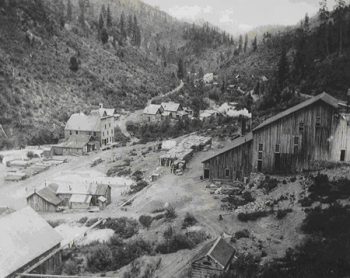 Washington State has quite ideal geographic characteristic for gold mining. The Columbia River runs from Canada and ends at Pacific Ocean. The river also drains all of the state’s water; in fact, it is the largest drainage in the Pacific Northwest. Such system allows for the existence of placer deposits throughout the gravels. However, the gold is most commonly in very fine form. The same thing applies to the Snake River which runs to Columbia in the southeast. You can consider the gold found in those waters leftover from other states. Traditional mining activities with panning may not be fruitful enough as it is too easy to lose gold in small sizes. This is probably the main reason why all the Washington gold mines never yielded large productions.
Washington State has quite ideal geographic characteristic for gold mining. The Columbia River runs from Canada and ends at Pacific Ocean. The river also drains all of the state’s water; in fact, it is the largest drainage in the Pacific Northwest. Such system allows for the existence of placer deposits throughout the gravels. However, the gold is most commonly in very fine form. The same thing applies to the Snake River which runs to Columbia in the southeast. You can consider the gold found in those waters leftover from other states. Traditional mining activities with panning may not be fruitful enough as it is too easy to lose gold in small sizes. This is probably the main reason why all the Washington gold mines never yielded large productions.
Total production so far is way lower compared to other states, but it does not change the fact that several millions of ounces have been found. For recreational prospectors, you probably will not come across a series of Washington gold mines with historical discoveries. Such places can still yield gold in other states, but you should not expect too much here. Metal detectors are not effective since the gold is distributed throughout creeks and rivers in very fine size. Best methods are traditional panning, sluice boxes, or suction dredging.
Gold prospecting regulations vary depending on areas. Some areas are private, managed by the federal government, or state-managed, so make sure you check with local agencies before you start panning those waters. A good gold claim map will keep you out of trouble. Washington Department of Fish and Game sets the regulations and there is a pamphlet that covers every related law you should know. Recreational gold prospecting and panning are far from illegal as long as you comply with those regulations.
Next Page »
 For recreational gold prospectors the fun and excitement in prospecting is not merely the hunt to find gold, but also the outdoor adventure and interaction with nature. Gold prospecting actually teaches some valuable life lessons: like the hard work miners put in to find gold, their hopes of discovering fortunes, and how they survived for many years during the gold rush. And most of those miners did not use modern gold prospecting equipment such as metal detectors, motorized sluice boxes, or modern suction dredges.
For recreational gold prospectors the fun and excitement in prospecting is not merely the hunt to find gold, but also the outdoor adventure and interaction with nature. Gold prospecting actually teaches some valuable life lessons: like the hard work miners put in to find gold, their hopes of discovering fortunes, and how they survived for many years during the gold rush. And most of those miners did not use modern gold prospecting equipment such as metal detectors, motorized sluice boxes, or modern suction dredges. . Instead of working one pan at a time the prospector slowly shovels the dirt into the mouth of the sluice box letting the natural flow of water wash the lighter materials away while also catching heavier materials like gold in the riffles. After a few hours of this process the miner takes the concentrates (sediment) from the bottom of the sluice box and pans that down to just the gold, hopefully.
. Instead of working one pan at a time the prospector slowly shovels the dirt into the mouth of the sluice box letting the natural flow of water wash the lighter materials away while also catching heavier materials like gold in the riffles. After a few hours of this process the miner takes the concentrates (sediment) from the bottom of the sluice box and pans that down to just the gold, hopefully.
 Sparkling gold in the bottom of a pan is one of the most rewarding experiences that any gold prospector can ask for–and the bigger the flakes and clinkers, the happier the prospector. While some say that hunting for gold is the most fun, the hunt will never be as much fun as actually finding gold. Hopefully the below listed gold prospecting locations will make the hunt worth it. But first, a few pro tips about gold prospecting to save time and money–because spending $1000 to find $100 worth of gold is not a strategy.
Sparkling gold in the bottom of a pan is one of the most rewarding experiences that any gold prospector can ask for–and the bigger the flakes and clinkers, the happier the prospector. While some say that hunting for gold is the most fun, the hunt will never be as much fun as actually finding gold. Hopefully the below listed gold prospecting locations will make the hunt worth it. But first, a few pro tips about gold prospecting to save time and money–because spending $1000 to find $100 worth of gold is not a strategy. Gold does not have a strong association with Wyoming. As a matter of fact, most people will think about cattle or oil when they are talking about the state. Compared to its neighboring states, Wyoming gets very little attention as far as gold mining is concerned. Population density is also lower than any other state, so it makes sense that gold exploration is not too popular here. Despite all of that, a good amount of gold has been recovered although not as much as from other states. Wyoming gold mines have never had their best season yet due to the nature of the state’s long and unfriendly winters.
Gold does not have a strong association with Wyoming. As a matter of fact, most people will think about cattle or oil when they are talking about the state. Compared to its neighboring states, Wyoming gets very little attention as far as gold mining is concerned. Population density is also lower than any other state, so it makes sense that gold exploration is not too popular here. Despite all of that, a good amount of gold has been recovered although not as much as from other states. Wyoming gold mines have never had their best season yet due to the nature of the state’s long and unfriendly winters. There is something unique about Utah. It is one of the leading states in terms of gold-production, but people do not seem to be very interested in the state for
There is something unique about Utah. It is one of the leading states in terms of gold-production, but people do not seem to be very interested in the state for  Over the past several hundred years, New Mexico has produced good amounts of gold. Total production is still lower than Arizona, but it does not necessarily mean that New Mexico is not a promising state. The first recorded gold discovery in the state happened in 1828 in Old Placers. The discovery was followed by establishments of many other New Mexico gold mines. Prior to 1904, total gold production from New Mexico was worth $6,750,000. Much of the gold is a byproduct of mining activities for other minerals. About a decade ago, all New Mexico gold mines ceased to exist. The state still produced gold in 2007, but all of them were byproducts of copper mining.
Over the past several hundred years, New Mexico has produced good amounts of gold. Total production is still lower than Arizona, but it does not necessarily mean that New Mexico is not a promising state. The first recorded gold discovery in the state happened in 1828 in Old Placers. The discovery was followed by establishments of many other New Mexico gold mines. Prior to 1904, total gold production from New Mexico was worth $6,750,000. Much of the gold is a byproduct of mining activities for other minerals. About a decade ago, all New Mexico gold mines ceased to exist. The state still produced gold in 2007, but all of them were byproducts of copper mining. Every county in Nevada has gold, even when some of them are so fine that it is not financially plausible for an average prospector to start looking in the first place. Many Nevada gold mines had records of historical finding of much friendlier size in the past, so it is best to focus on those places for the most part. It is well worth the cost to buy a
Every county in Nevada has gold, even when some of them are so fine that it is not financially plausible for an average prospector to start looking in the first place. Many Nevada gold mines had records of historical finding of much friendlier size in the past, so it is best to focus on those places for the most part. It is well worth the cost to buy a  Montana and Idaho stand side by side. Most gold in Montana has been found in the western part of the state near the border of Idaho. This part is filled with difficult terrain of rugged mountains along the Continental Divide; almost all the remaining parts of the state are flat land areas. The geological conditions are probably not ideal, but no one ever said finding gold is easy.
Montana and Idaho stand side by side. Most gold in Montana has been found in the western part of the state near the border of Idaho. This part is filled with difficult terrain of rugged mountains along the Continental Divide; almost all the remaining parts of the state are flat land areas. The geological conditions are probably not ideal, but no one ever said finding gold is easy. The first important gold discovery in South Dakota occurred in 1874 by a group of people led by General Custer. The area was later known as the Black Hills, and the news attracted quite a lot of people in search of fortunes despite the difficulties and challenges presented by the local Sioux Indians. Even after hundreds of years of initial discovery, Black Hills remain one of the most attractive South Dakota gold mines for modern day prospectors. It has been explored extensively ever since, but many believe that it still hides plenty of gold.
The first important gold discovery in South Dakota occurred in 1874 by a group of people led by General Custer. The area was later known as the Black Hills, and the news attracted quite a lot of people in search of fortunes despite the difficulties and challenges presented by the local Sioux Indians. Even after hundreds of years of initial discovery, Black Hills remain one of the most attractive South Dakota gold mines for modern day prospectors. It has been explored extensively ever since, but many believe that it still hides plenty of gold. Among all states in the country, Idaho is one of the most productive in terms of
Among all states in the country, Idaho is one of the most productive in terms of  Washington State has quite ideal geographic characteristic for gold mining. The Columbia River runs from Canada and ends at Pacific Ocean. The river also drains all of the state’s water; in fact, it is the largest drainage in the Pacific Northwest. Such system allows for the existence of placer deposits throughout the gravels. However, the gold is most commonly in very fine form. The same thing applies to the Snake River which runs to Columbia in the southeast. You can consider the gold found in those waters leftover from other states. Traditional mining activities with panning may not be fruitful enough as it is too easy to lose gold in small sizes. This is probably the main reason why all the Washington gold mines never yielded large productions.
Washington State has quite ideal geographic characteristic for gold mining. The Columbia River runs from Canada and ends at Pacific Ocean. The river also drains all of the state’s water; in fact, it is the largest drainage in the Pacific Northwest. Such system allows for the existence of placer deposits throughout the gravels. However, the gold is most commonly in very fine form. The same thing applies to the Snake River which runs to Columbia in the southeast. You can consider the gold found in those waters leftover from other states. Traditional mining activities with panning may not be fruitful enough as it is too easy to lose gold in small sizes. This is probably the main reason why all the Washington gold mines never yielded large productions.

